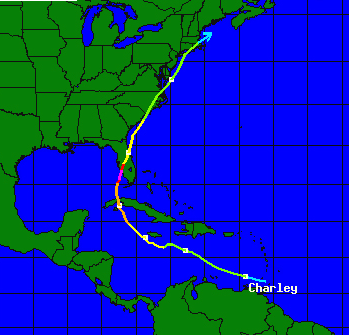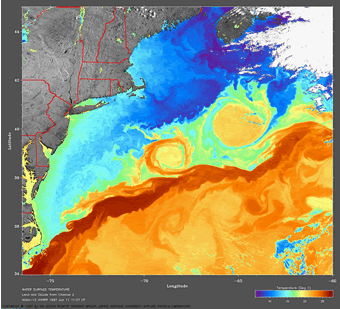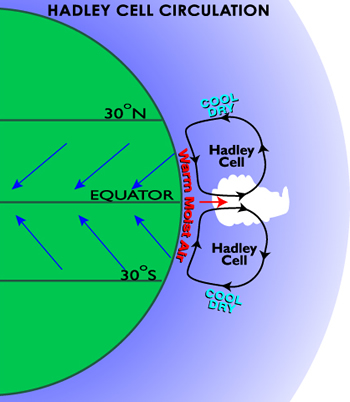Click on image for full size
Map courtesy of the Perry-Castaneda Library at the University of Texas
Related links:
The Coriolis Effect
To understand what the Coriolis effect is, let's imagine that you're on the top of a mountain in Arizona and you have a cannon. You want to fire a cannonball and hit a flag pole that's on the top of another mountain due north of you in Montana, almost a thousand miles (1600 km) away. If the Earth weren't rotating you would want to point your cannon due north.But the Earth is rotating. Everything on Earth including our mountain, our cannon, our cannonball, and ourselves moves toward the east as the Earth spins around. So, if we point our cannon due north, our cannonball will be moving eastward as well as northward. From our perspective it will look like the cannonball starts out heading due north but that's only because we're moving eastward too, at the same speed.
Now, the flag pole in Montana is also moving eastward but not as fast. Why? Because it doesn't have as far to go. This is easiest to understand if you look at a globe. Every point on the surface of the Earth spins around toward the east and returns to the same place every 24 hours. A place near the equator has a long way to go - it has to make a big circle all the way around the Earth. However, a point near the north pole only has to make a little circle around the pole to get back to where it started. Since both points need to complete their journey in 24 hours, the one near the equator has to move much faster.
So let's return to our target practice. We fire our cannon due northward but our cannonball is also moving eastward. The flag pole in Montana is moving eastward but not as fast - it can't catch up to the cannonball! So we'll miss our target - our cannonball will land east of the flag pole. From our perspective in Arizona, it will look like our cannonball veered to the right. What should we have done? We should have pointed our cannon to the northwest. Then our cannonball would veer a bit to the right and if we were careful - bang - a hole in one!
Why did we use a cannonball and not a football? Because something has to move a very long way before the Coriolis effect is noticable - at least several hundred miles. When you throw a football the path only curves a tiny bit due to the Coriolis effect - far too small for you to ever notice.
The Coriolis effect makes moving objects appear to curve toward the right in the northern hemisphere and toward the left in the southern hemisphere. In our example the cannon was pointing north but a similar thing would happen no matter which way we pointed it. If our cannon was pointed east our cannonball would appear to veer toward the south. If our cannon was pointed south our cannonball would appear to veer toward the west, and so on. The trajectory depends on your latitude - the farther you are from the equator the more the cannonball will appear to curve.
The Coriolis effect not only works with cannonballs, it also works on winds and ocean currents. It's what makes hurricanes spin around. It's also important on other planets, in stars, and in interstellar clouds.















